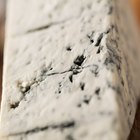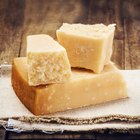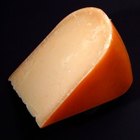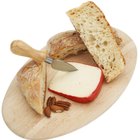
The word cheddar can traditionally bring to mind a thick slice of bright orange cheese. However, white cheddar is now claiming shelf space at grocery stores as well. Except for the color, there is actually very little difference between white and yellow or orange cheddar cheeses.
Features
Cheddar cheese is a harder cheese that can range from mild to very sharp in flavor. Whether yellow or white, the cheese must be aged to achieve its distinctive flavor; the longer the aging process, the sharper the cheddar.
Differences
The main difference between white and yellow cheddar is usually a simple food coloring, which was originally added to distinguish where the cheddar was made. Cheddar cheeses made in the New England states, for example, traditionally do not contain color additives and, thus, retain their natural white coloring while Wisconsin cheddar cheese is often colored with annatto, a natural food coloring, to give it its trademark yellow image.
Process
Cheddar cheese, whether white or yellow, is made from cow's milk. After the milk is curdled, the whey is drained and the curds are piled up, forming the base of the cheese. The bright yellow or orange cheddars on display at grocery stores owe their coloring to food dyes and color additives, such as annatto.
Misconceptions
Many people claim to taste a difference between white and yellow cheddar cheese. In fact, all yellow cheddar is actually white cheddar with coloring. The additives do not contribute to the taste. Cheddar cheeses differ in taste based on sharpness due to aging. It is also worth taking into consideration whether the cheese has been heavily processed or is natural, and what region it comes from. For example, according to "Cheese Guru" Andy Shay, cheddars made in Ontario, Canada, tend to be pasteurized and have a sharp, pleasant bite while Quebec cheddars are often made from raw milk and are lightly fruity in flavor.
Fun Facts
Cheddar cheese originated in a village called Cheddar, located in Somerset County, England. The village is also known for producing a large amount of strawberries.
Aged cheddar cheeses contain 0 grams of lactose.
Related Articles

Facts About Gouda Cheese

Can You Eat the Skin on Muenster Cheese?

How to Order Cooper Sharp Cheese
How to Pan-Fry Cheese

What Good Bacteria Is in Cheese?

What Types of Cheeses Are Unpasteurized?

Aged Cheeses That Do Not Melt

How Much Fat Is in Feta Cheese?

MSG and Parmesan Cheese

Does Blue Cheese Spoil?

How to Store Parmigiano Reggiano

The Difference Between Fresh Cheese & ...

What Is Animal Rennet?

What Makes a Cheese Mild, Medium or ...

Manchego Cheese and Nutrition

Cheeses Similar to Feta

Does a Sliced American Cheese Product ...
List of High Temperature Cheeses

A List of Dutch Cheeses

Types of Cheese Used in Pizza
References
Writer Bio
Kara Page has been a freelance writer and editor since 2007. She maintains several blogs on travel, music, food and more. She is also a contributing writer for Suite101 and has articles published on eHow and Answerbag. Page holds a Bachelor of Music Education degree from the University of North Texas.
Photo Credits
Image by Flickr.com, courtesy of Chris Buecheler